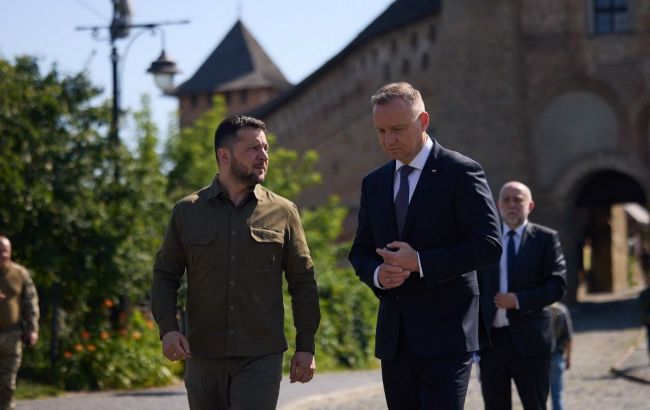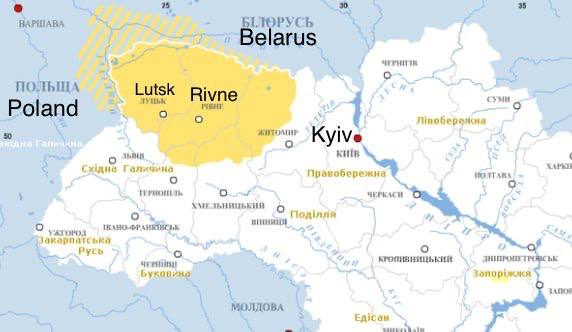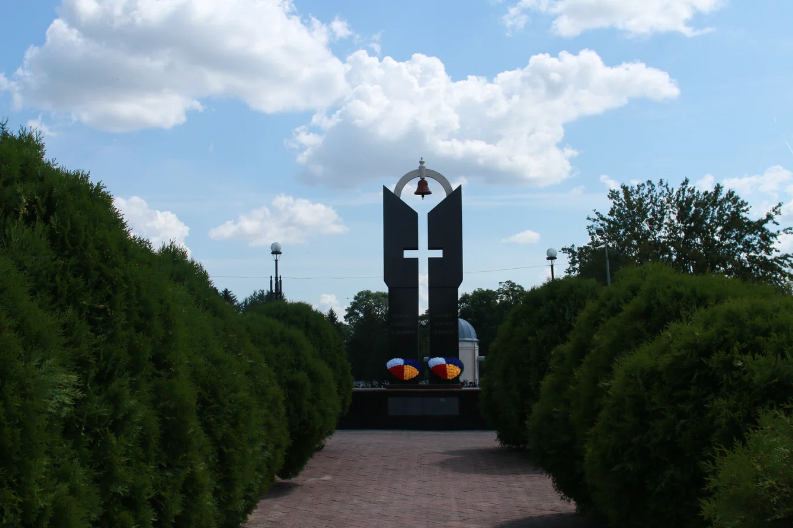Volhynia tragedy: Why events of 80 years ago 'poison the dialogue' between Ukraine and Poland
 Photo: Volodymyr Zelenskyy and Andrzej Duda at the events commemorating the anniversary of the Volhynian tragedy in Lutsk, July 2023 (president.gov.ua)
Photo: Volodymyr Zelenskyy and Andrzej Duda at the events commemorating the anniversary of the Volhynian tragedy in Lutsk, July 2023 (president.gov.ua)
Poland supports Ukraine in many aspects - from military confrontation with Russia to accession to NATO and the European Union. However, the tragic pages of their shared history, specifically the Volhynia tragedy of 1943-1944, remain a contentious issue.
RBC-Ukraine explains the essence of the problem - why the events of 80 years ago "poison the political dialogue" between the two countries.
Contents
- Volhynia tragedy of 1943-1944: Historical background
- Ukrainian perspective and the formula 'We ask for forgiveness and we forgive'
- Polish perspective: Targeted genocide
- Is the Volhynia tragedy a reason to block Ukraine's EU accession?
- Exhumation issue may gain momentum
Volhynia tragedy of 1943-1944: Historical background
The Volhynia tragedy is a bloody episode of the Ukrainian-Polish conflict during World War II, occurring in the territories where Ukrainians and Poles coexisted—Volhynia, Eastern Galicia, Chelm, Podlasie, Nadsania, and Lemkivshchyna.
The Polish side interprets it as an anti-Polish action by the Ukrainian Insurgent Army (UPA) and as genocide. In contrast, the Ukrainian perspective emphasizes the motivations of the UPA and the corresponding actions of the Polish Home Army against peaceful Ukrainians.
The essence of the issue is outlined in a report based on the research of historians Ihor Illiushyn and Yaroslav Hrytsak, prepared for the guide Together on the same land. The history of Ukraine is multicultural (it is worth noting that Hrytsak's evaluations and conclusions about these events are disputed by other experts).
The report states that in the spring of 1943, the leadership of the Organization of Ukrainian Nationalists (OUN) decided to expel the Poles. At that time, Ukrainians made up about 80% of the population in Volhynia, while Poles accounted for approximately 15%.

Photo: The Volhynia tragedy occurred in the northwestern regions of Ukraine (Wikipedia)
The decision was justified by the necessity to thwart plans to return the Western Ukrainian lands to Poland, as well as to punish the Poles for collaborating with the Nazis, assisting Soviet partisans, and for the murder of Ukrainian public figures in Chelm.
Initially, the actions were isolated and targeted against Polish collaborators of the Nazi administration. However, they gradually became mass movements and spread throughout the Polish countryside.
From July 11 to 13, 1943, UPA units attacked over 100 Polish settlements (though many historians believe this figure is significantly exaggerated). In response, the command of the Home Army created its partisan units and organized self-defense bases. They also began punitive actions against the peaceful Ukrainian population.
According to Polish estimates, at least 35,000 predominantly Polish peasants died in the Volhynia tragedy (18,000 of whom have identified surnames). Some historians estimate the number of Polish casualties to be two to three times higher, reaching up to 100,000.
From the Ukrainian side, estimates were conducted at the village level. According to these estimates, losses among Ukrainians were three times lower. Other estimates suggest that the number of Ukrainian casualties across all conflict areas reached 21,000 to 24,000.
Ukrainian perspective and the formula 'We ask for forgiveness and we forgive'
The Ukrainian side is committed to the formula "We ask for forgiveness and we forgive": asking for forgiveness for the suffering caused by representatives of the Ukrainian people and forgiving Polish crimes, as well as refraining from engaging in a "competition" over the number of victims from either side.
The Volhynia tragedy is referred to as a horrific event of the past in the materials of the Ukrainian Institute of National Remembrance (UINP). It emphasizes the need to study all circumstances and consequences, as well as to take responsibility for them.
The events of 80 years ago were fueled by Nazi and communist regimes to weaken both the Polish and Ukrainian underground movements.
The anti-Polish actions of Ukrainians from 1943 to 1945 indeed involved mass killings of Polish civilians, who were an ethnic minority in Volhynia. Armed nationalists were joined by local Ukrainian residents who had long suffered oppression from Polish authorities. At the same time, Polish units of the Home Army and peasant battalions also resorted to mass killings of Ukrainian civilians not only in Volhynia but also in Poland, notes the UINP.

Photo: Monument to the victims of the tragedy in Volhynia region (Local History)
According to more recent data, the names of approximately 30,000 Polish and 10,000 Ukrainian victims of mass killings have been established.
Ukrainian institutions and the academic community are working to form a more honest and thoughtful perspective based on facts and an understanding of the context.
"This perspective cannot be black-and-white. We recognize the contribution of Ukrainians in the struggle for statehood and independence by the OUN and UPA. At the same time, those who participated in the murders cannot be unconditionally glorified and must face condemnation," the Institute of National Remembrance believes.
Polish perspective: Targeted genocide
In Polish historiography, the tragedy is referred to as the Volhynia massacre or the Volhynia crime. The Organization of Ukrainian Nationalists (OUN), its subordinate Ukrainian Insurgent Army (UPA), and the Ukrainian population are named as the perpetrators.
The first mass killing of Poles is considered to be the attack on the village of Paroslya on February 9, 1943. In the spring, those who had escaped service in the Nazi army joined the ranks of the insurgent army. The wave of violence intensified, and on July 11-12, during attacks on over 100 settlements, 10,000 to 11,000 Poles were killed.
According to material by the Polish Institute of National Remembrance, even Ukrainians died at the hands of the nationalists. Additionally, in The Kresy Book of the Righteous 1939-1945 by Romuald Niedzielko, it is stated that 384 Ukrainians lost their lives while rescuing Poles.
Based on estimates from Polish historians, about 100,000 Poles perished in the Volhynia tragedy - up to 60,000 in Volhynia, up to 40,000 in Eastern Galicia, and at least 4,000 in the territories of present-day Poland. As a result of retaliatory actions by the Home Army, 10,000 to 12,000 Ukrainians were killed, including between 3,000 to 5,000 in Volhynia and Eastern Galicia.

Photo: Monument to the victims of the Volhynia tragedy in Domostaw, Subcarpathian Voivodeship, Poland (Wikipedia)
"Although the anti-Polish action was ethnic cleansing, it also meets the definition of genocide. The goal was to destroy the entire Polish ethnic group in Volhynia and partially in other areas," says historian Professor Grzegorz Motyka.
Every year on July 11, Poland honors the victims of the tragic events in Volhynia. This day is also known as Bloody Sunday and is officially recognized as the National Day of Remembrance for the Victims of the Genocide Committed by Ukrainian Nationalists against the Citizens of the Second Republic of Poland.
In 2016, the Polish Sejm recognized the events in Volhynia as genocide against the Polish people. The Polish people react very painfully to gestures and statements that are directly or indirectly related to these events. For example, in 2022, they were outraged by a selfie taken by General Valerii Zaluzhnyi against the backdrop of a bust of Stepan Bandera, even though it was trolling the Russians.
Sociological data in Poland shows that half of the population is waiting for an apology for the Volhynia tragedy from Ukrainian President Volodymyr Zelenskyy.
Is the Volhynia tragedy a reason to block Ukraine's EU accession?
Despite differing approaches to reconciliation, the main issue remains the exhumation of Polish victims. This topic has even become a subject of speculation regarding Ukraine's accession to the European Union.
In July, Polish Defense Minister Władysław Kosiniak-Kamysz stated that Warsaw should not approve Ukraine's EU membership until the "Volhynia question" is resolved. In August, then Foreign Minister of Ukraine Dmytro Kuleba, during a panel discussion, referenced Operation Vistula (the forced relocation of Ukrainians in 1947 to the west and north of Poland) when asked about the start of exhumations.
"Do you know that all these Ukrainians (the discussion took place in Vilshany - ed.) were forcibly relocated from Ukrainian territories to various places in Poland? If we start to go digging through history today, then the nature of our discussions would be completely different, and we would be able to very deeply embarrass ourselves through history and needle each other on the bad things that Poles have done to Ukrainians, and Ukrainians to Poles," he said.
According to him, there are no problems with exhumation, but Ukraine asks to honor the memory of Ukrainians, and then "we will move forward in mutual respect." Some Polish politicians were outraged that Kuleba referred to parts of Polish territory as Ukrainian. Prime Minister Donald Tusk stated that he would not allow the country to join the EU without resolving historical issues.
However, there is no unanimous opinion within Poland itself. Marshal of the Sejm, Szymon Hołownia, believes that all discrepancies should be discussed after accession. President Andrzej Duda opposed using the Volhynia tragedy as leverage, stating that it "aligns with Putin’s policies."
"I hope that by the end of my presidency, there will be some breakthrough on this issue. On the other hand, I would not want this to happen through blackmail, which, in my opinion, will not lead to good results," he noted.
A few days later, Deputy Foreign Minister of Poland Teofil Bartoszewski stated that the issue of exhumations would be discussed within the framework of negotiations regarding the first chapter of the EU's acquis communautaire on the rule of law and justice.
Yesterday, new Ukrainian Foreign Minister Andrii Sybiha met with the president and other top Polish officials.
"Ukraine is ready to talk with Poland on all topics; true friends can... not only talk but also solve problems. We discussed specific technical steps to finally resolve the exhumation issue, which has long poisoned our political dialogue. It is pleasant to note that we have mutual understanding and a desire to move forward constructively," he reported.
Exhumation issue may gain momentum
The institutions of national remembrance have developed a draft regulation for the corresponding working group, but it has not been approved by the Polish side since 2021. In the summer of 2022, the ministries of culture signed a memorandum to create a joint working group for the search, exhumation, and protection of burial sites. The memorandum is to come into effect after the lifting of martial law.
However, the issue of exhumations has still been raised by Poland. Last year, Ukraine responded positively, and research was conducted in the Chortkiv district of the Ternopil region. At the beginning of 2024, historical issues were brought to the forefront during intergovernmental consultations. The Ministry of Culture approved the composition of the Ukrainian part of the working group, but as of October 1, 2024, there is no information regarding the formation of the Polish part.
At the same time, Ukraine's request to restore the memorial plaque for UPA soldiers on Mount Monastyr remains unfulfilled, even though it was a subject of negotiations between Presidents Duda and Zelenskyy.
"The above leaves the question open regarding the Polish side's readiness for parity and equal relations with Ukraine in the field of historical memory," noted the Ukrainian Institute of National Remembrance (UINP).
This year, the UINP began receiving requests from Poland for the exhumation of the remains of their relatives in the Rivne region. Search operations are intended to be included in plans for 2025.
"The UINP leans towards a decision to meet the interests of Polish citizens and, as an exception, to take on the role of coordinator in conducting search operations at the request of Polish citizens, inviting the Polish side as an observer," said the head of the institute, Anton Drobovych.
Sources: statements from Ukrainian and Polish officials, materials from the National Memorial Institutes of Ukraine and Poland, and reference data based on the research of historians Ihor Illiushyn and Yaroslav Hrytsak.

